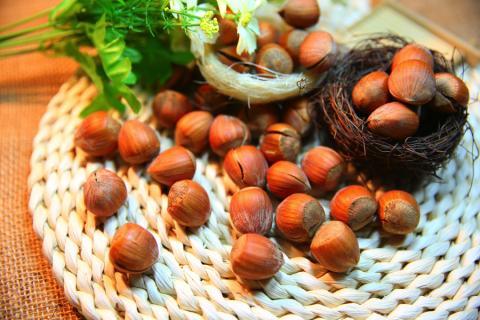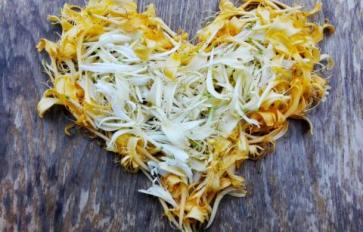
Hearty Snacks: Fruits and Nuts
Pomegranates:
Average Cost In U.S. and Midwest Region
$2.13 per fruit
Time to Reach Maturity: 12– 36 months
Scraps to Garden:
- Remove the seeds from the ripe fruit
- Discard any flesh and rinse them thoroughly
- Allow them to dry completely
- Plant 2-3 seeds in a pot (that has drainage holes)
with potting soil, covering the seeds about 1/4 inch deep
- Surround the pot with foil paper and place in direct sun. Doing this speeds up the germination process which usually takes 30-40 days
- When it has sprouted a few inches, transplant to the garden
- Plant in a sunny area with well drained soil
- The soil should have a pH level of 7.5-8
- You can add some organic liquid fertilizer when the tree is established to enhance fruit production
Fun Facts
- Pomegranates can be used to make three different color dyes. Red from the fruit, yellow from the skin and black from the roots.
- Pomegranate trees can live for over 200 years.
- Pomegranates are known as the fruit of the dead in ancient Greek mythology.
Pineapples:
Average Cost In U.S. and Midwest Region
$2- $5 per pineapple
Time to Reach Maturity: 24 Months
Scraps to Garden:
- Save the top of the pineapple
- Remove the flesh of the fruit
- Allow it to dry for 1-2 days
- Remove all the small bottom leaves and all dead leaves from the pineapple
- Plant the top in a pot or in your garden
- Give it a little water if the soil is very dry
- Plant the fruit in a place that allows for the leaves to spread out without overcrowding
- If you are planting a few, place them each about a foot apart
- If you plant them in the winter make sure they get a generous amount of sunlight during the spring and summer months
- Save the suckers and slips of the fruit once it matures to replant. The suckers and slips usually grow within a year, reducing your wait time and multiplying your fruit yield
Fun Facts:
- Pineapples belong to the bromeliad family and do not have a prominent root system.
- Pineapples stop ripening after they are harvested.
- In Maui and Jamaica pineapples are used to make wine.
- The pineapple plant produces berries that merge together to form flowers with colors varying from lavender to bright red.
Cherries:
Average Cost In U.S. and Midwest Region
$4.99 per pound
Time to Reach Maturity:
Dwarf Kind Cherry Trees produce fruit after 36 months, giving about 10-15 quarts of cherries per year
Standard size takes 48 months and yields 30 – 40 quarts per year
Scraps to Garden:
- Choose full round pits from the cherry; don’t use damaged or wrinkled pits
- Remove all traces of the fruit from the pit by washing and air drying
- Put the pits in a covered seed flat filled with potting soil
- Keep it stored in the fridge at a temperature below 40 degrees Fahrenheit and allow to germinate for about 12 weeks
- Remove from fridge after twelve weeks, moisten the soil by spritzing with some water
- Place them in moderate sunlight
- Gradually expose the seeds to more and more sunlight as little seedlings start to spring up
- Keep the soil moist
- When the seedlings have at least two sets of leaves, transplant them to the soil, planting them 3 feet deep
- Plant where the soil is well drained and the tree will be exposed to at least 6 hours of full sunlight
Fun Facts:
- Cherries are a member of the rose family.
- Tart cherries offer better pain relieving properties than aspirin and ibuprofen, minus the liver damage.
- Cherries and herbs like sage, chives and verbena are a match made in heaven.
- Japanese culture considers the cherry tree to be a valued plant. They gifted the United States with 3020 cherry blossom trees in 1912 as a symbol of friendship.
Hazelnuts:
Average Cost In U.S. and Midwest Region
$0.70 per pound
Time to Reach Maturity
After 2-4 years yields 25 pounds of nuts annually
Scraps to Garden
- Test the nuts by throwing them in a bucket of water: the ones that sink will grow, the ones that float are not good candidates
- Air dry your hazelnuts
- Put a small notch in the nut before planting to facilitate faster germination
- Plant 2-3 seeds 1 inch deep in pots with light potting soil
- Plant 2 trees at a time as they need to pollinate each other to produce fruit
- Let the tree grow to about 1 foot before transplanting to the soil
- Transplant to an area with full sun and well drained soil
- The soil should be slightly acidic to neutral
- Dig the hole to twice the size of the root ball of the tree
- Plant both trees no more than 20 feet apart to allow them to pollinate each other
- Keep the saplings moist for the first few months
Fun Facts
- Italy has a Hazelnut Day, which falls on December 14, during which they celebrate the significance of the seed culturally and nutritionally.
- Hazelnut contains the highest amount of vitamin E in the nut family.
- “Love is a fruit in season at all times and within the reach of every hand. Anyone may gather it and no limit is set. Everyone can reach this love through meditation, prayer, sacrifice and an intense inner life.” Mother Teresa
References
- https://www.ams.usda.gov/mnreports/fvwretail.pdf
- http://www.todayshomeowner.com/how-to-grow-pomegranate-plants-from-seed/
- https://ag.arizona.edu/yavapai/anr/hort/byg/archive/pomegranates.html
- http://www.tropicalpermaculture.com/growing-pineapples.html
- http://www.huffingtonpost.com/2014/02/04/facts-about-pineapples_n_4726366.html
- http://homeguides.sfgate.com/prepare-cherry-pits-planting-germination-68796.html
- http://www.food-skills-for-self-sufficiency.com/growing-hazelnuts.html
- https://www.finedininglovers.com/stories/hazelnuts-beneficts-facts-figures/








